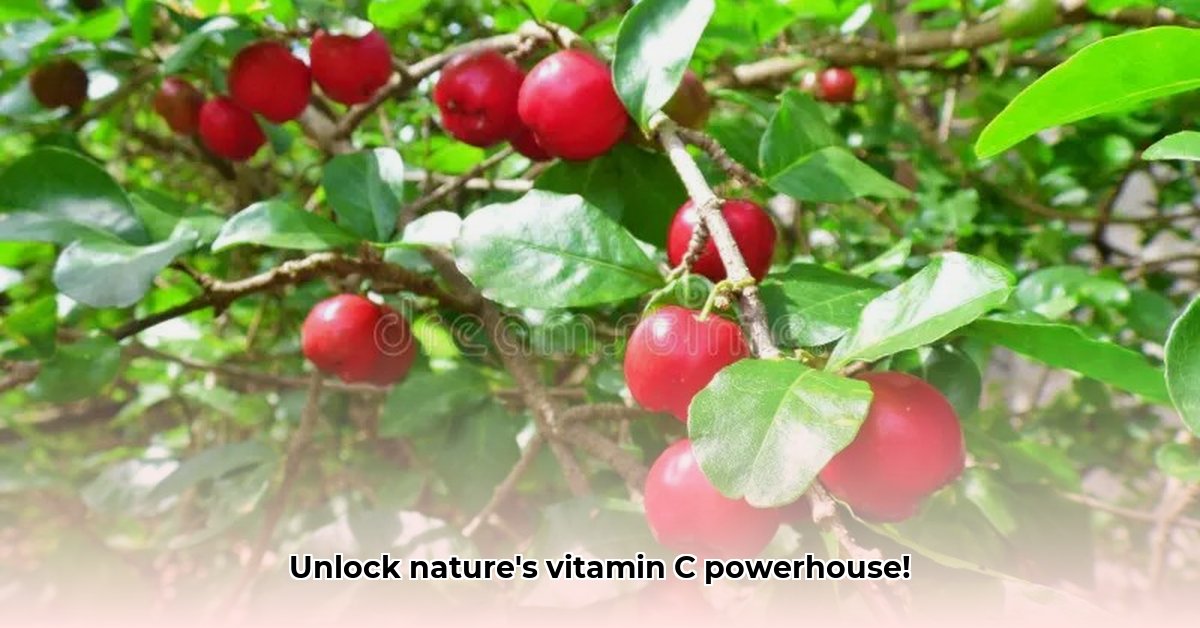Interested in cultivating a superfood brimming with Vitamin C that’s also in high demand? Discover the secrets to profitable acerola production! This comprehensive guide provides step-by-step instructions, taking you from tree selection to harvesting and marketing your crop. Whether you’re an experienced farmer or just starting out, you’ll learn effective, easy-to-implement techniques for growing acerola. We’ll delve into planting, nurturing, and safeguarding your trees, optimizing yield, and innovating with value-added products like juices and jams. Discover how to make your farm both profitable and environmentally responsible through proven strategies and inspiring success stories. Get ready to cultivate exceptional acerola, naturally! For more information on acerola trees, check out this helpful guide: Learn more.
Unlocking Acerola Cultivation: A Comprehensive Guide to a Vitamin C-Rich Harvest
Thinking about growing your own acerola trees? Excellent choice! These small trees pack a significant nutritional punch, being exceptionally rich in Vitamin C, a crucial antioxidant that combats cellular damage. Acerola cultivation offers a fulfilling experience suitable for gardeners of all skill levels. Here’s how to maximize your success in cultivating these nutritional powerhouses.
Cultivar Selection: Choosing the Right Acerola Variety for Optimal Fruit Production
Selecting the appropriate acerola cultivar is a crucial first step. While both fruiting and ornamental varieties exist, focus on fruiting types for a productive harvest. Malpighia emarginata is the leading choice, renowned for its abundant and Vitamin C-rich fruit. Research indicates that selecting appropriate cultivars can enhance yields by up to 40 percent. Certain cultivars exhibit superior disease resistance or adaptability to specific climate conditions, further emphasizing the importance of informed selection.
Propagation Techniques: Establishing Your Acerola Orchard
Starting your acerola trees is an exciting phase. Acerola can be propagated through seeds, cuttings, or grafting. Here’s a breakdown:
-
Seed Propagation: While possible, this method presents challenges, including lower germination rates and potential variability in fruit quality. Seedlings may not consistently produce fruit with the desired traits.
-
Cuttings (Vegetative Propagation): This method is often preferred, especially for beginners, offering higher success rates and genetic consistency. Cuttings from healthy, established trees reliably produce clones of the parent plant. Follow these steps:
- Sourcing Cuttings: Collect 6-8 inch cuttings from healthy, actively growing branches of a mature acerola tree. Avoid woody or excessively old stems. The ideal cutting diameter is approximately pencil-sized.
- Preparing Cuttings: Remove the leaves from the lower two-thirds of the cutting, leaving a few leaves at the top to support photosynthesis. This minimizes moisture loss and prevents potential rot.
- Rooting Hormone Application: Dip the cut end of each cutting into a rooting hormone powder or solution. This significantly promotes root development and increases success rates. Indole-3-butyric acid (IBA) is a commonly used and effective rooting hormone.
- Planting Media: Plant cuttings in a well-draining potting mix such as a blend of perlite and vermiculite. This combination provides excellent aeration and moisture retention, crucial for root development. Avoid using garden soil, which can be too heavy and may harbor pathogens.
- Creating a Humid Environment: Enclose the planted cuttings in a clear plastic bag or humidity dome to maintain high humidity levels. This reduces water loss and encourages root formation. Regularly mist the cuttings to maintain moisture.
- Light and Location: Position the cuttings in a warm location with bright, indirect sunlight. Direct sunlight can scorch the delicate cuttings. Ideal temperatures range from 70-80°F (21-27°C).
- Monitoring and Patience: Root development typically takes several weeks. Maintain consistent soil moisture, but avoid overwatering. Check for root development by gently tugging on the cuttings. Resistance indicates root formation.
- Transplanting: Once a robust root system has developed, carefully transplant the rooted cuttings into individual pots or containers with a well-draining potting mix. Gradually acclimate the young plants to outdoor conditions before transplanting them into the ground.
-
Grafting: This advanced technique involves joining a scion (cutting) from a high-yielding cultivar onto a compatible rootstock. Grafting combines the desirable traits of both plants, resulting in vigorous growth and superior fruit quality. Although requiring horticultural expertise, grafting yields a success rate of approximately 75% when performed by skilled professionals. Common grafting methods include the cleft graft and the whip graft.
Planting and Soil Preparation: Creating the Ideal Environment for Acerola Farming
Acerola trees flourish in sunny locations with well-drained soil and a slightly alkaline pH. Before planting, thoroughly amend your soil with organic compost or well-rotted manure. This improves drainage, aeration, and nutrient availability. Space your seedlings or grafted trees approximately 15-20 feet apart to allow ample room for mature growth.
Consider conducting a soil test to determine the specific nutrient requirements of your soil. Adjustments may be necessary to optimize the soil pH and nutrient levels for optimal growth. In areas with poor drainage, consider planting on raised beds to prevent root rot.
Pest and Disease Management: Safeguarding Your Acerola Trees
Acerola trees can be vulnerable to various pests and diseases. Regular monitoring facilitates early detection and timely intervention. Common pests include aphids, whiteflies, spider mites, and fruit flies. Diseases can include root rot, anthracnose, and cercospora leaf spot. Implementing an integrated pest management (IPM) strategy is crucial for sustainable pest and disease control. This involves a combination of techniques:
-
Beneficial Insects: Encourage natural predators such as ladybugs and lacewings to control pest populations.
-
Pruning: Regular pruning not only shapes the tree but also improves air circulation, reducing humidity and the likelihood of fungal diseases.
-
Organic Pesticides: Use organic pesticides such as neem oil or insecticidal soap sparingly and only when necessary, targeting specific pests to minimize harm to beneficial insects.
-
Resistant Varieties: Select cultivars known for their resistance to common pests and diseases in your region. Research continues to identify and develop more resistant varieties.
-
Crop Rotation and Sanitation: Avoid planting acerola in areas previously affected by soilborne diseases. Remove and destroy infected plant material to prevent the spread of disease.
Nutrient Management: Feeding Your Acerola Trees for Abundant Growth
Consistent fertilization is essential for healthy growth and abundant fruit production. Apply a balanced, slow-release fertilizer specifically formulated for fruit trees. Incorporate compost or well-rotted manure into the soil to improve soil structure and nutrient availability. Conduct regular soil tests to monitor nutrient levels and adjust fertilizer applications accordingly.
Foliar feeding with micronutrients can also be beneficial, particularly if deficiencies are identified. Be sure to follow the manufacturer’s instructions for application rates and timing.
Irrigation Strategies: The Art of Watering Acerola Trees
Acerola trees require consistent moisture, but overwatering can predispose them to root rot and other diseases. Water deeply and infrequently, allowing the soil to dry slightly between waterings. Mulching around the base of the trees helps retain soil moisture, suppress weeds, and moderate soil temperature. Drip irrigation is an efficient method for delivering water directly to the root zone.
Monitor soil moisture levels regularly, especially during dry periods. Adjust watering frequency as needed based on weather conditions and plant needs.
Harvesting and Post-Harvest Handling: Maximizing Your Acerola Yield
Acerola fruits are ready for harvest when they develop a deep red color and are slightly soft to the touch. Harvest fruits carefully to avoid bruising. Acerola fruits are highly perishable, so process them quickly to maximize their shelf life.
Consider these post-harvest options:
-
Fresh Consumption: Market and sell fresh acerola fruits directly to consumers or retailers.
-
Juice Production: Extract juice from the fruits and sell it fresh or processed.
-
Jam and Preserves: Process the fruits into jams, jellies, and preserves.
-
Freezing: Freeze whole fruits or pulp for later use.
-
Drying: Dry the fruits to create a concentrated powder for use in supplements and food products.
Proper storage and handling are crucial to prevent spoilage and maintain quality. Refrigerate fresh fruits immediately after harvest.
Market Analysis and Value-Added Products: Turning Harvest into Profit
Acerola’s high Vitamin C content creates significant market opportunities. Explore these avenues:
-
Local Farmers’ Markets: Sell fresh acerola fruits or processed products directly to consumers at local farmers’ markets.
-
Direct Sales to Consumers: Offer subscriptions or online sales to reach a wider customer base.
-
Wholesale to Retailers: Supply fresh acerola fruits or processed products to local grocery stores and health food stores.
-
Value-Added Products: Develop and market innovative value-added products such as acerola juice blends, jams, dietary supplements, and cosmetic ingredients.
-
Contract Growing: Partner with supplement manufacturers or food companies to supply acerola fruits under contract.
Conduct thorough market research to identify the most promising market channels and product opportunities.
Stakeholder Collaboration: A Cooperative Approach to Sustainable Acerola Farming
Successful acerola cultivation relies on collaboration among diverse stakeholders. Consider these perspectives:
| Stakeholder Group | Potential Strengths | Potential Challenges | Possible Solutions |
|---|---|---|---|
| Smallholder Farmers | Direct connection to consumers, lower start-up costs | Market access, pest/disease management, processing | Cooperatives, value |
- Plant Based Diet Breast Cancer: Research-Based Benefits - December 16, 2025
- Plant-Based Diet Ulcerative Colitis Remission: Proven Benefits - December 15, 2025
- Plant-Based Diet and Fibroids: Reduce Symptoms Now - December 13, 2025










